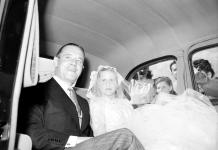
1895 At first blush, a woman identified only as “Norma” appears in this circa-1895 photo to be breezily pedaling her way down Putnam Street in what is now known as Midtown Detroit. But there was much more social and cultural freight attached to women bicycling in the 1890s than the photo reveals.
Bicycling allowed women a degree of independence they hadn’t enjoyed before. No longer did they have to ask their husbands’ permission for a jaunt in a horse and carriage or a ticket for a train ride. Instead, they could go where and when they wanted on a two-wheeler. Bicycling also freed women from restrictive fashion; it was simply unpragmatic to wear constraining corsets or clunky bustles while riding. They now wore pantaloons and free-flowing skirts.
No less a feminist than Susan B. Anthony reveled in how the bicycle elevated women’s spirits in the 1890s. In an article for the Smithsonian Institution, Hannah S. Ostroff quotes Anthony as saying: “Bicycling … has done more to emancipate women than anything else in the world. It gives women a feeling of freedom and self-reliance. I stand and rejoice every time I see a woman ride by on a wheel … the picture of free, untrammeled womanhood.”
Additionally, the design of bicycles changed to accommodate the female form. The original high-wheel bicycle morphed into the “safety bicycle,” allowing women more freedom of movement and less danger of flying headfirst over the handlebars. Bicycle manufacturers concentrated their marketing on female consumers, not only in the United States, but in Europe as well. In a segment on PBS’ Antiques Roadshow, poster expert Nicholas Lowry appraised two 1890s German posters of women on bicycles, one of whom he described as a “self-confident, emancipated woman.”
The vogue for bicycles got the wheels turning for women’s emancipation in the 1890s, and the coming emergence of the automobile likely buttressed their desire for even more freedom, which they found in the driver’s seat.
|
|
|









